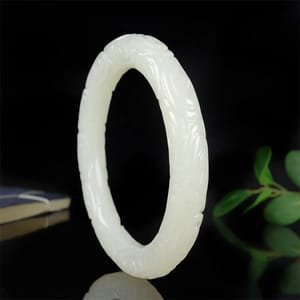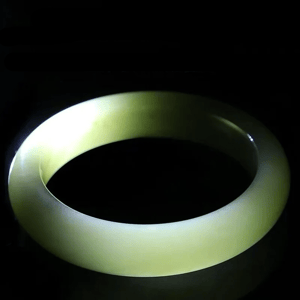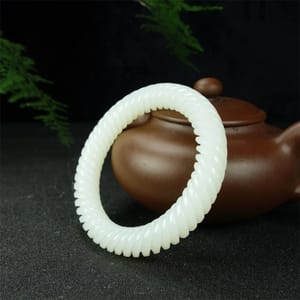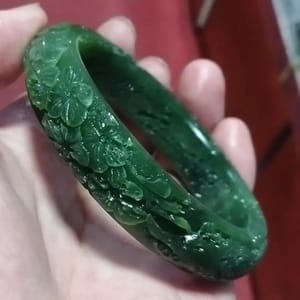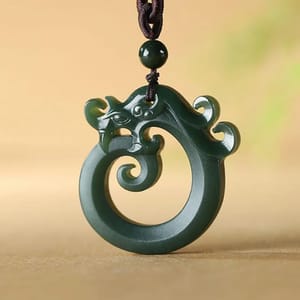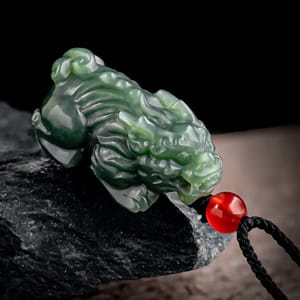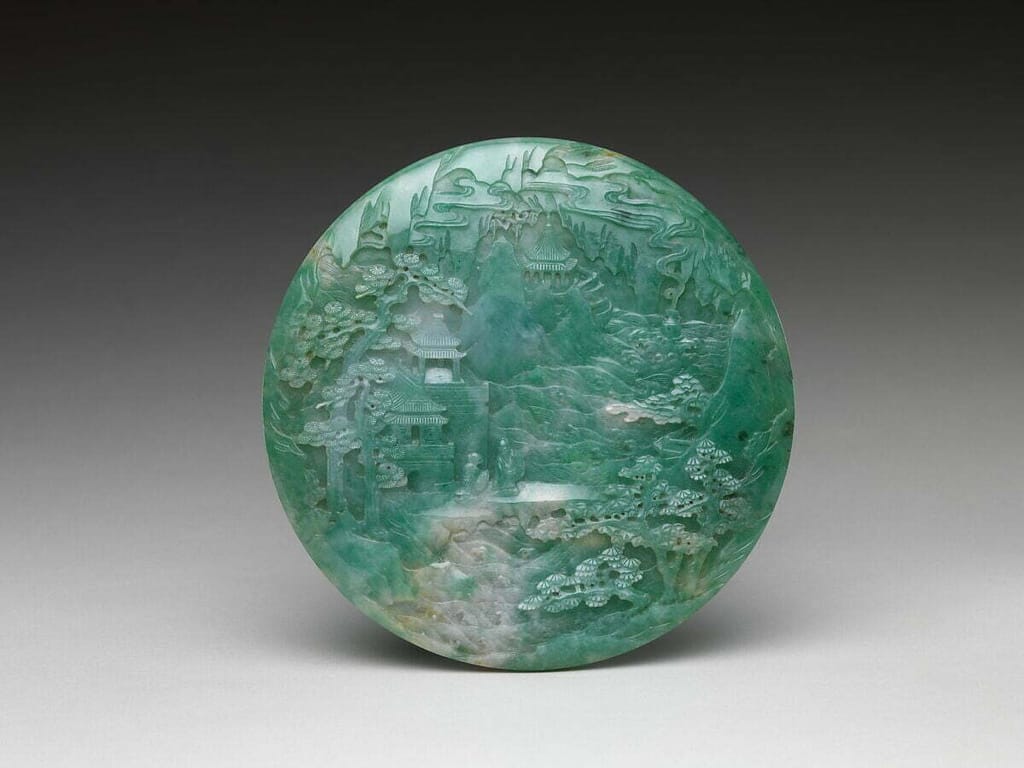Nephrite Jade: The Properties, History, and Significance of Nephrite
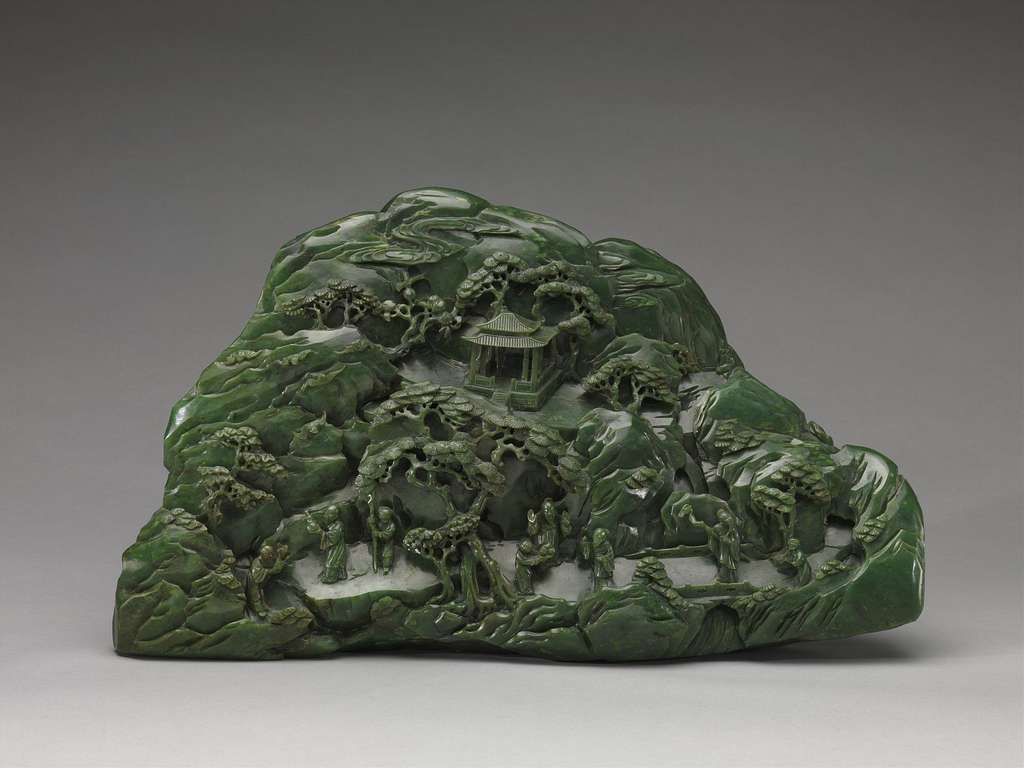
Nephrite jade is a semi-precious stone belonging to the amphibole mineral group. It is one of two minerals classified as jade, the other being jadeite. Nephrite is a dense, tough, and compact mineral, composed of interlocking microcrystalline fibers. Its unique properties, such as its vibrant colors, fine texture, and toughness, make it highly sought after for both ornamental and practical uses.
Comparing Nephrite vs Jadeite vs Jade
Though both nephrite and jadeite are considered jade, they are two distinct minerals with unique properties. Here are the key differences between them:
- Composition: Nephrite is a calcium magnesium silicate mineral, while jadeite is a sodium aluminum silicate mineral. This difference in chemical composition results in distinct physical and optical properties.
- Color: Nephrite jade is typically found in shades of green, ranging from pale to deep green. However, it can also occur in other colors, such as white, brown, black, yellow, blue, and even red. Jadeite, on the other hand, has a more extensive color range and the color tends to be more vivid, including vivid green, lavender, red, orange, and even blue. Jade’s color significantly influences its value and desirability.
- Hardness: Both minerals are relatively hard, but jadeite is slightly harder (6.5-7 on the Mohs scale) compared to nephrite (6-6.5 on the Mohs scale).
- Density: Nephrite is denser than jadeite, with a specific gravity ranging from 2.9 to 3.1, whereas jadeite’s specific gravity is between 3.2 and 3.4.
- Rarity: Jadeite is rarer and often more valuable than nephrite, although some high-quality nephrite stones can rival jadeite in price.
To learn more about the differences between jade, jadeite, and other green gems like emeralds, you can explore this comparison of jade vs. emerald.
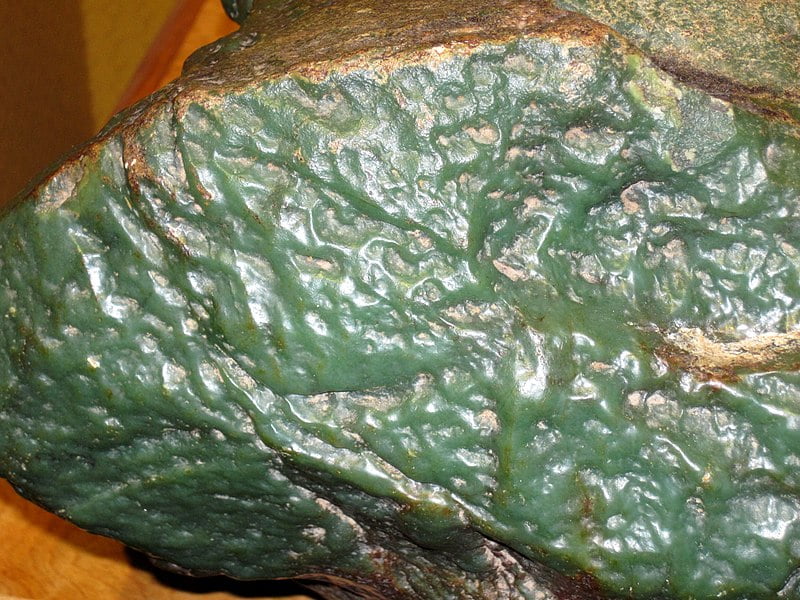
Tracing the Origins of Nephrite Jade: A Brief History
The history of nephrite jade dates back thousands of years, with evidence of its use across various cultures and regions. Some of the key points in nephrite jade’s history include:
- Neolithic Europe: Nephrite was used in the Neolithic period, around 6000-3000 BCE, for making tools, weapons, and ornaments due to its toughness and durability.
- Ancient China: Chinese culture has revered nephrite jade for over 5,000 years, associating it with purity, virtue, and spiritual protection. It was used to create intricate carvings, ritual objects, and decorative items for the imperial court.
- Māori culture: In New Zealand, the indigenous Māori people have a long history of using nephrite, known as pounamu or greenstone, for creating tools, weapons, and ornamental objects. Pounamu holds great spiritual significance and is considered a taonga (treasure) in Māori culture.
- Modern uses: Today, nephrite is used for various purposes, including creating stunning jewelry pieces like earrings, pendants, necklaces, and bangles. It is also popular for crafting intricate carvings, ornaments, and other decorative items.
Physical Properties of Nephrite Jade
Color
Nephrite can be found in various colors, ranging from white and cream to gray, yellow, brown, and black. However, it is most commonly known for its shades of green, which can vary from pale to deep green. The color is often influenced by the presence of iron and chromium ions in the mineral’s structure. The color plays a significant role in determining its value and desirability in the market.
Hardness
Nephrite has a hardness of 6 to 6.5 on the Mohs scale, making it a relatively hard and tough gemstone. The interlocking fibrous structure of nephrite contributes to its exceptional toughness, which has made it a preferred material for tools, weapons, and ornaments throughout history.
Luster
Nephrite jade possesses a unique lustrous sheen known as “greasy” or “waxy” luster. This characteristic sheen sets it apart from other gemstones and adds to its visual appeal. Polishing nephrite enhances its luster, making it perfect for creating elegant jewelry and decorative items.
Fracture Pattern
Nephrite has a distinct fracture pattern, characterized by a rough, splintery, or granular surface. This unique fracture pattern results from the interlocking fibrous structure of nephrite, which contributes to its exceptional toughness and durability. The fracture characteristics can aid gemologists and collectors in distinguishing it from other similar-looking gemstones.
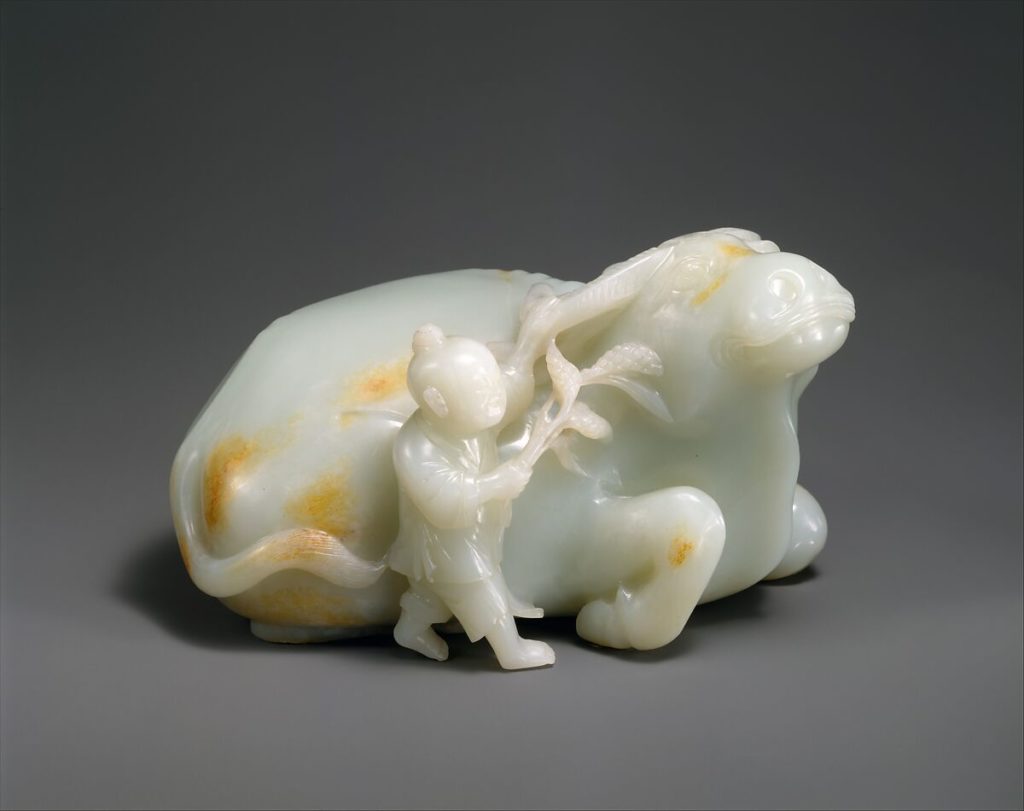
Chemical Properties of Nephrite Jade
Chemical Composition
Nephrite jade is a calcium magnesium silicate mineral belonging to the amphibole group. Its chemical formula is Ca2(Mg,Fe)5Si8O22(OH)2, where the ratio of magnesium to iron can vary. The variation in chemical composition can result in differences in color, hardness, and specific gravity.
Specific Gravity / Density
Nephrite has a specific gravity ranging from 2.9 to 3.1, making it denser than jadeite, which has a specific gravity between 3.2 and 3.4. The specific gravity of nephrite jade can help gemologists and collectors distinguish it from jadeite and other similar-looking gemstones.
Absorption Spectrum
The absorption spectrum of nephrite is a unique characteristic that can help identify the stone. Nephrite has several characteristic absorption bands in the visible and near-infrared regions of the electromagnetic spectrum. This “light signature” can be used to confirm the identity of it and differentiate it from other gemstones, such as jadeite.
Refractive Index
Nephrite jade has a refractive index ranging from 1.606 to 1.632, with an average value of 1.614. The refractive index, which measures the extent to which light is bent or refracted as it passes through the mineral, can be another useful tool for identifying nephrite and distinguishing it from similar gemstones like jadeite, which has a higher refractive index ranging from 1.640 to 1.667.
Optical Properties of Nephrite
Luminescence
Nephrite jade does not exhibit luminescence, which is the emission of light when the mineral is exposed to ultraviolet (UV) light, due to its iron content. This test is used on jadeite, which exhibits a weak luminescence depending on its origin.
Pleochroism
Pleochroism refers to the ability of a mineral to display different colors when viewed from different angles. Although nephrite jade exhibits weak pleochroism, it is generally not noticeable in most specimens. However, certain jade stones may show subtle color changes under specific lighting conditions or when viewed from different angles.
Birefringence
Birefringence is the optical property of a material that causes light to split into two separate rays when it passes through the material. Nephrite jade has a low birefringence, typically ranging from 0.005 to 0.010. This low level of birefringence means that the double refraction effect is not easily observable, unlike in some other gemstones like calcite or zircon.
History and Cultural Significance of Nephrite Jade
Name Origin and Etymology
The term “nephrite” is derived from the Latin word “lapis nephriticus,” which means “kidney stone.” This name originated from the ancient belief that nephrite jade could cure kidney ailments and other internal disorders. The word “jade,” on the other hand, comes from the Spanish phrase “piedra de ijada” or “stone of the flank,” also referring to the belief that the stone could alleviate pain and protect the body’s vital organs.
The First Uses of Nephrite Jade
Nephrite jade was highly valued and utilized in Neolithic and Chalcolithic Europe, dating back to around 5000 BCE. Artifacts from this period, including polished axes, adzes, and other tools, demonstrate the importance of nephrite as a functional material. Its strength and toughness made it an ideal material for creating tools, weapons, and ceremonial objects.
Ancient China
In ancient China, nephrite jade held great cultural significance, symbolizing wealth, power, and virtue. Chinese artisans crafted nephrite into intricate ornaments, ritual objects, and burial items for royalty and the elite. The stone was also believed to possess protective and healing properties, which contributed to its widespread use throughout Chinese history.
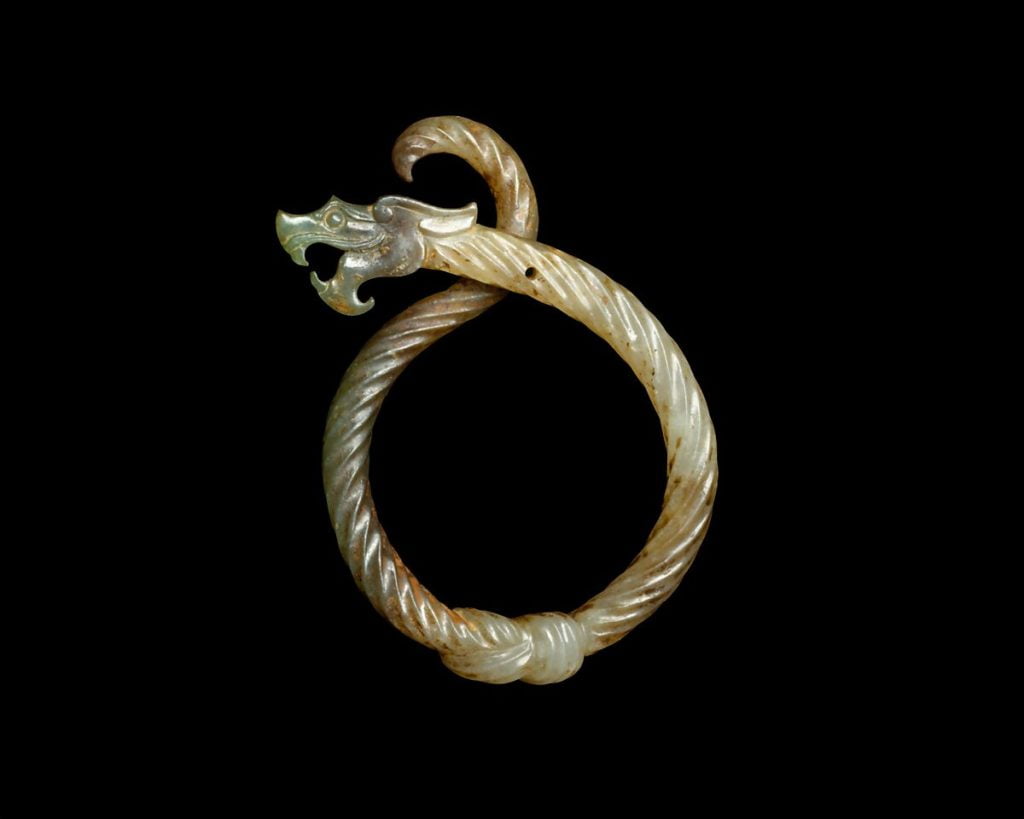
Prehistoric Taiwan and Southeast Asia
Nephrite jade was also highly valued in prehistoric Taiwan and Southeast Asia, where it was used for crafting tools, weapons, and ornaments. The stone’s durability and unique appearance made it a popular material for creating functional and decorative items. Nephrite jade artifacts from this region, such as bracelets, beads, and pendants, showcase the remarkable craftsmanship and artistic skill of the ancient artisans.
Māori Culture and Pounamu
For the Māori people of New Zealand, nephrite jade or “pounamu” holds great spiritual and cultural significance. Pounamu is considered a taonga or treasure, and it is believed to possess powerful protective properties. Māori artisans skillfully crafted pounamu into various forms, including weapons, tools, and ornamental objects. Today, pounamu continues to be an important symbol of Māori culture and identity.
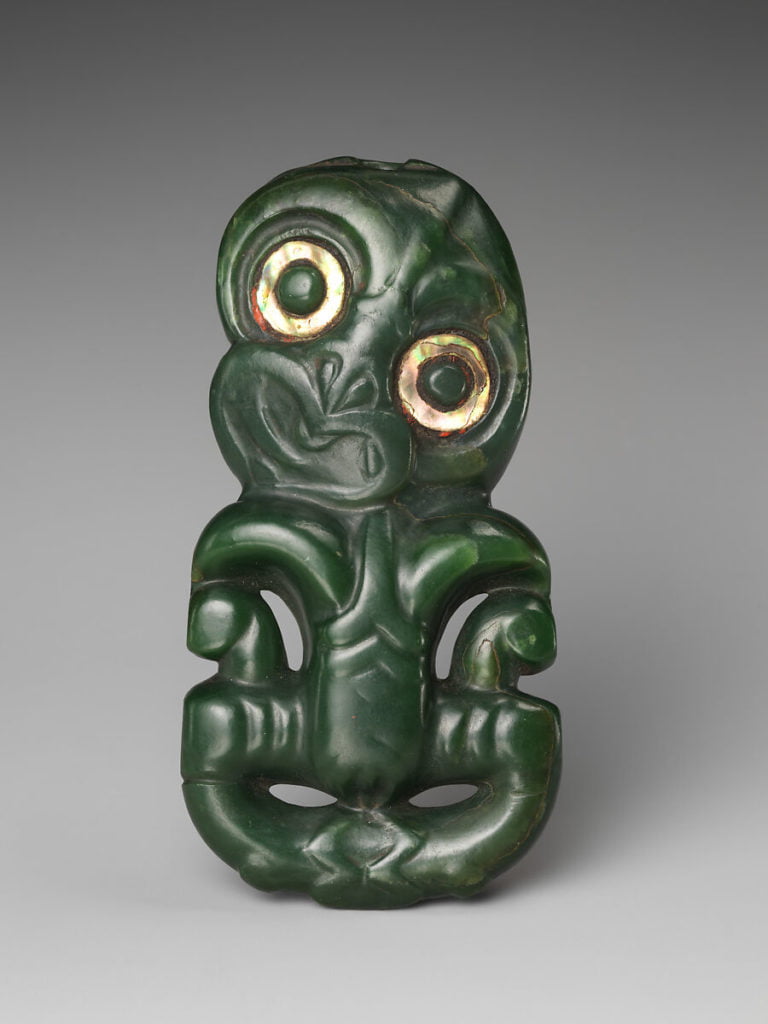
Modern Art
Nephrite jade remains a popular material in modern art and design, with artists and craftsmen from various cultures creating stunning pieces that showcase the stone’s beauty and versatility. From elegant jewelry to intricate carvings and sculptures, nephrite continues to captivate and inspire with its rich history.
Value of Nephrite Jade
What Determines the Value of Nephrite Jade?
The value of nephrite is determined by several factors, including:
- Color: In general, high-quality nephrite exhibits a rich, even color, with the most valuable specimens possessing a deep, vibrant green hue. In China white jade has been the most prized jade throughout history. In other areas, such as Big Sur, high quality blue or red jades can be the most desirable.
- Translucency: The level of translucency can significantly impact the value of nephrite, with more translucent stones typically commanding higher prices.
- Texture: Finely-grained, smooth-textured nephrite is generally more valuable than those with a coarse, fibrous texture.
- Carving and craftsmanship: Intricate and skillfully crafted pieces, particularly those with historical or cultural significance, can command higher prices.
Nephrite vs Jadeite
While both nephrite and jadeite are considered jade, they have distinct differences in their mineral composition, appearance, and value. Jadeite is typically more valuable than nephrite due to its rarity, vibrant colors, and higher level of translucency. However, high-quality nephrite jade, especially those with exceptional color and translucency, can still command significant prices.
Size
The size of a nephrite stone can impact its value, with larger, high-quality specimens often commanding higher prices. However, size is not the only factor that determines the value of nephrite jade, as color, translucency, and craftsmanship are also essential considerations.
Rarity
Nephrite jade is more abundant than jadeite, but high-quality nephrite is still relatively rare. The scarcity of top-grade nephrite, combined with its cultural and historical significance, contributes to its value in the market.
Why is Nephrite Jade Expensive?
The price of nephrite is influenced by factors such as rarity, quality, and craftsmanship. High-quality nephrite with exceptional color, translucency, and texture can command high prices, especially if it is skillfully carved or has cultural significance. Additionally, the demand for nephrite jade in the market, driven by collectors and enthusiasts, can also contribute to its price.
Current Market Trends
Current market trends for nephrite jade include a growing appreciation for its historical and cultural significance, leading to increased demand for antique and culturally significant pieces. Additionally, there is a rising interest in sustainable and ethically sourced nephrite, with consumers seeking transparency regarding the origin and mining practices associated with the stones they purchase.
Nephrite Jade Jewelry Care
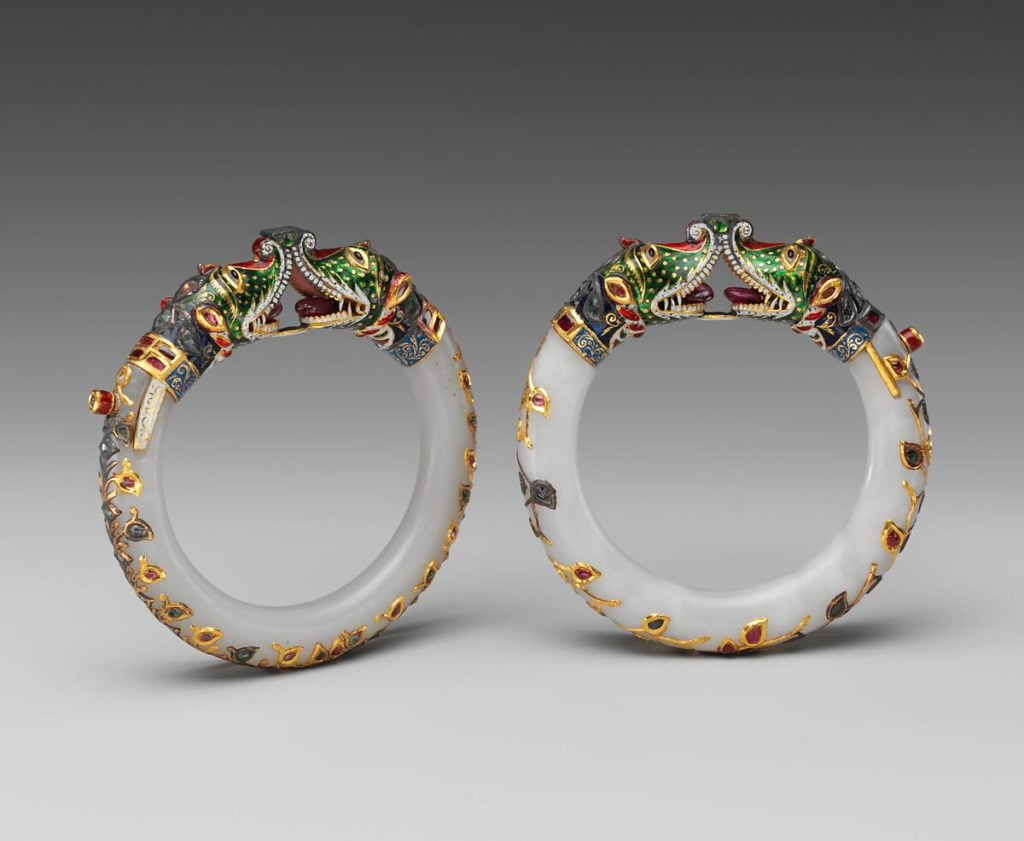
Is It a Good Choice for Jewelry?
Nephrite is an excellent choice for jewelry due to its durability, unique appearance, and cultural significance. The range of jade colors and textures makes it suitable for various types of jewelry, from pendants and necklaces to bangles and rings.
Tips for Caring for Nephrite Jade Jewelry
To ensure the longevity and beauty of your nephrite jewelry, follow these care tips:
- Gentle cleaning: Use a soft cloth or a gentle brush with mild soap and water to clean your jade jewelry. Avoid harsh chemicals or abrasive materials that could damage the stone. Nephrite is porous, an can absorb chemicals and cleaners. Due to this property, however, the appearance of nephrite can improve as you wear it, as it will absorb the oils from your skin.
- Proper storage: Store your jade jewelry in a soft pouch or a separate compartment in your jewelry box to prevent scratches or damage from other pieces. Nephrite is a tough and dense stone, so while it itself isn’t easily damaged, it can damage other jewelry.
- Be cautious with ultrasonic cleaners: While some nephrite can be safely cleaned with an ultrasonic cleaner, it’s best to consult a professional jeweler before using this method to avoid potential damage.
Can Nephrite Jade Get Wet?
Yes, nephrite can get wet. Nephrite jade is generally water-resistant and can be safely worn while washing hands or during light water exposure. However, it is advisable to remove your jade jewelry before swimming, or participating in activities that involve prolonged water exposure, as chemicals in the water can potentially damage the stone.
Synthetic Nephrites
Do They Exist?
Synthetic nephrite jade does not exist, as the complex mineral composition and structure of nephrite have not been successfully replicated in a laboratory setting. However, there are various imitation materials, such as serpentine or glass, that can be mistaken for nephrite jade. These imitations may be marketed as synthetic nephrite, but they do not possess the same properties or characteristics as genuine jade.
Imitation jadeite does exist, and has been created in a laboratory setting, however it is generally more expensive to create jadeite than using the real stone. It is more common for low quality stone to be impregnated with dyes or artificially colored.
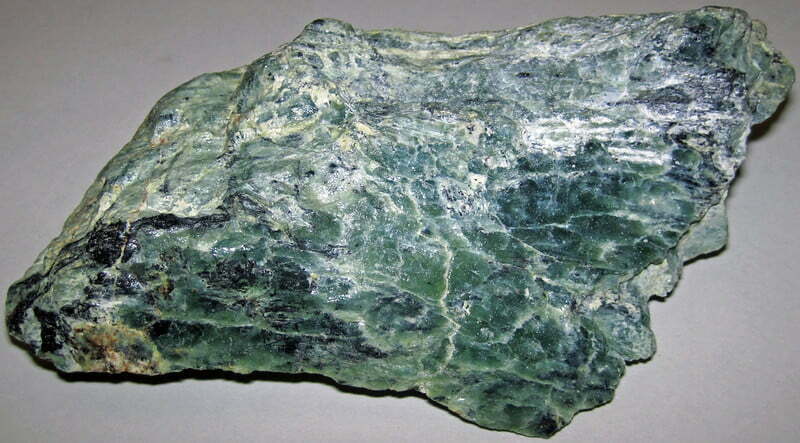
Enhancing Nephrite Gemstones: Common Practices
While nephrite is not typically treated or enhanced, some techniques may be used to improve its appearance, such as:
- Polishing: A high-quality polish can enhance the natural luster and translucency of nephrite.
- Dyeing: Some lower-quality nephrite jade may be dyed to improve its color, but this practice is not as common as it is with jadeite.
- Waxing: Nephrite may be coated with wax to improve its luster and protect its surface.
Real vs. Fake: Distinguishing Genuine Nephrite
It can be challenging to differentiate genuine nephrite jade from imitations, especially for those who are not familiar with the stone’s characteristics. Here are some tips to help identify real jade:
- Color: Genuine nephrite typically exhibits a smooth, even color with no unnatural streaks or patterns.
- Texture: Authentic nephrite has a fine-grained, compact, and smooth texture.
- Hardness: Nephrite has a hardness of 6 to 6.5 on the Mohs scale, making it resistant to scratches from materials with a lower hardness. A test is commonly preformed by people who look for jade by trying to scratch jade with a steel knife. Steel is softer than jade on the hardness scale, and will not scratch pure jade.
Testing for Authenticity: How to Verify Real Nephrite Jade
To accurately determine the authenticity of nephrite jade, it is essential to consult a professional gemologist or a reputable jade dealer. Some tests that can help verify real nephrite include:
- Specific gravity test: Genuine nephrite has a specific gravity of 2.90 to 3.03, which can be measured using specialized equipment.
- Refractive index test: Nephrite has a refractive index of 1.606 to 1.632, which can be measured using a refractometer.
- Scratch test: Genuine nephrite jade should not be easily scratched by materials with a lower hardness on the Mohs scale.
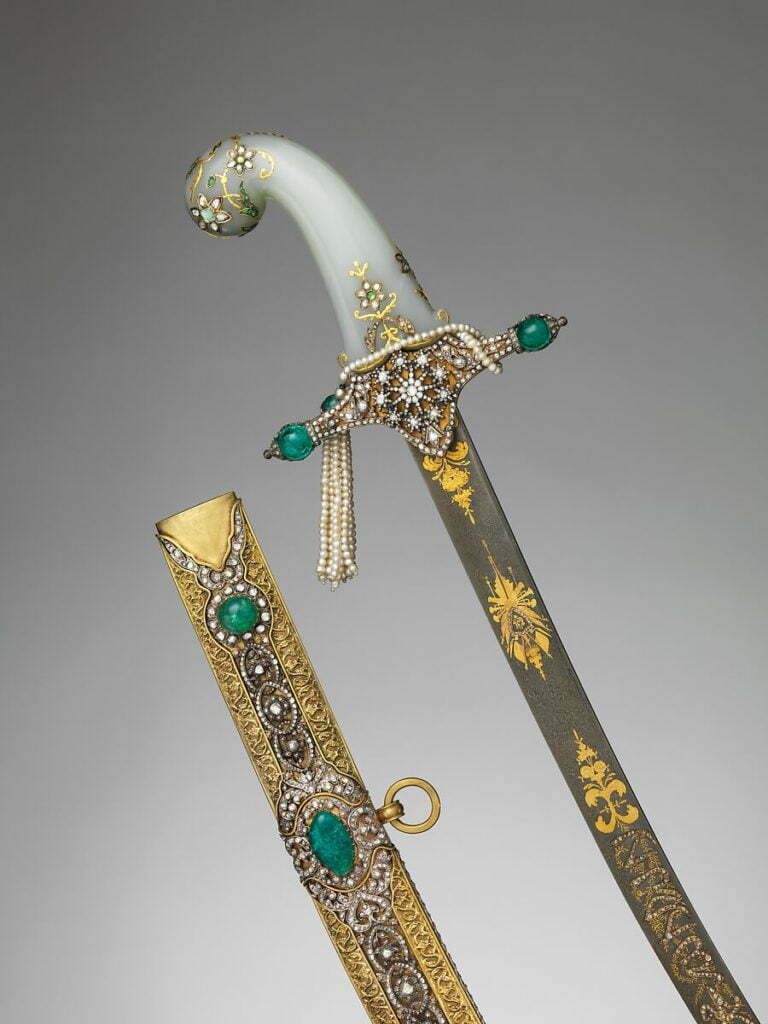
Sources and Controversies
Where Is It Found Worldwide?
Nephrite jade is found in various locations around the world, with significant deposits in countries such as China, Russia, Canada, New Zealand, and the United States. Some well-known sources include:
- British Columbia, Canada
- Wyoming, United States
- Siberia, Russia
- New Zealand’s South Island
For more information explore our article where is jade found.
Australian Nephrite
Australia is home to a small but significant deposit of nephrite jade, primarily located in Western Australia’s Pilbara region. Australian nephrite is known for its unique colors, ranging from green to black and even blue, and is highly sought after by collectors and enthusiasts.
The Xinjiang Conflict
Nephrite jade from Xinjiang, China, has been a subject of controversy due to concerns about human rights abuses and forced labor in the region. It is essential for consumers to be aware of these issues and make informed decisions when purchasing jewelry or raw stone from this region. Jade sourced from Xinjiang is banned in the United States.
Legal and Ethical Considerations
It is crucial to consider legal and ethical factors when purchasing nephrite jade, such as:
- Sourcing: Ensure that the nephrite jade is sourced from reputable and legally compliant mines that adhere to sustainable and responsible mining practices.
- Disclosure: Gem dealers should disclose any enhancements or treatments applied to nephrite, as well as the stone’s origin and mining practices.
- Fair labor practices: Ensure that the jade you purchase is produced under ethical working conditions that prioritize the well-being and fair treatment of workers involved in the mining, cutting, and polishing processes.
Sustainable Mining Practices
Sustainable and responsible mining practices are crucial in the nephrite jade industry to minimize environmental impact and ensure the long-term availability of this precious gemstone. Consumers should support businesses that prioritize ethical sourcing, fair labor practices, and environmentally responsible mining techniques.

Nephrite Jade Meaning and Metaphysical Properties
Symbolism and Cultural Significance
Nephrite jade has been revered for thousands of years for its symbolism and cultural significance. It has been associated with various meanings, such as protection, prosperity, and good luck. Learn more about the meaning and symbolism of jade.
Healing Properties and Spiritual Meaning
Nephrite jade is believed to possess healing properties and spiritual meaning, often associated with the heart chakra. It is said to promote emotional balance, attract love, and encourage forgiveness. Some people also believe that nephrite jade can help with physical ailments, such as kidney problems and immune system disorders.
Nephrite jade is believed to offer various therapeutic effects, including:
- Enhancing emotional healing and releasing negative emotions
- Attracting love and fostering healthy relationships
- Strengthening the immune system and promoting physical healing
Nephrite Jade in Feng Shui
In Feng Shui, nephrite jade is thought to bring balance, harmony, and prosperity to a space. It is often used in wealth-enhancing areas of the home, such as the southeast sector, and can also be used to promote health and well-being in the east sector.
Personal Growth and Healing
To harness the benefits of nephrite jade, you can:
- Wear nephrite jade jewelry, such as rings or bracelets.
- Meditate with a nephrite jade stone to promote emotional healing and balance
- Place nephrite jade pieces in your living space to enhance the energy and promote a sense of harmony
- Incorporate nephrite jade into your spiritual or healing practices, such as reiki or crystal therapy
Recharging Your Nephrite Jade
To maintain the energy of your nephrite jade, it is essential to cleanse and recharge it regularly. You can recharge nephrite jade by:
- Placing it under moonlight, especially during a full moon
- Burying it in the earth for a short period to reconnect with the grounding energy of the earth
- Using the cleansing properties of other crystals, such as selenite or clear quartz
Skeptical Viewpoints
While many people believe in the metaphysical properties of nephrite jade, it’s essential to recognize that there is limited scientific evidence to support these claims. Skeptics argue that the healing effects of nephrite jade may be attributed to the placebo effect or the power of suggestion.
Nonetheless, many individuals find comfort, beauty, and personal meaning in the use of nephrite jade for spiritual and emotional purposes. As with any belief system, it’s important to approach the subject with an open mind and make decisions based on your own experiences and beliefs.
